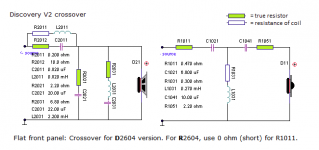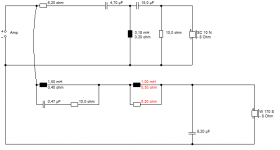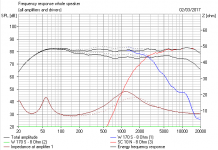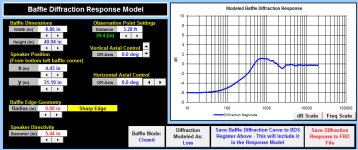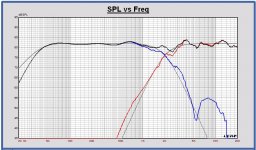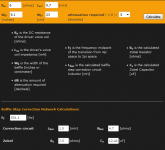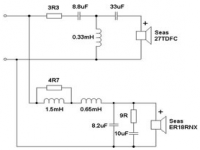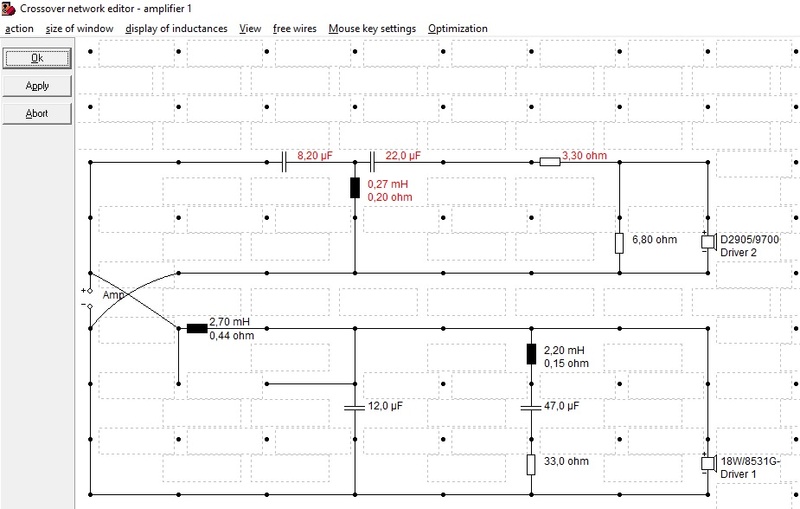
THat looks like Zaph's filter with a mild LCR presence notch. It's not really what Troels does at all with an LCR.
18W-8434G00
His general idea is below.
I was looking at Michael Chua's 6" Starling design:
http://www.ampslab.com/starling.htm
Michael Chua said:Another issue with the ER18 is the pronounced rising response above 500Hz. If left unattended, the midrange will be overly emphasized, resulting in a rather tiring listening experience.
It actually works well. The 1mH coil in parallel with a resistor works as a broad presence notch, a bit like Troels' LCR idea. Might be worth a go. But you'll need a smaller coil around 1mH. The 2.2mH might be OK for the first section.
Attachments
Hi Lojzek,
Maybe there are some doubts about the baffle response curve that you add.
Hey Paul, this is what I used.
Attachments
ok, right now I have made some adjustements to filter01, could you try to work on this? it's very better than the other, very good but maybe it needs some adjustements

Cucicu,
This is the response of your last filter, filter 02
SPL with fllter 02 and LR4 2000Hz targets
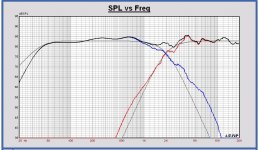
schematic filter 02
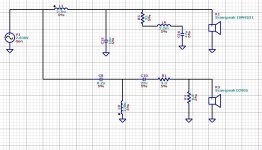
You see that the overall response is more flat. I will look to some adjustments to even make it better on target.
Hey Paul, this is what I used.
Hi Lojzek,
These are the Leap results.
SPL on infinite baffle (pink) and in free space (blue)
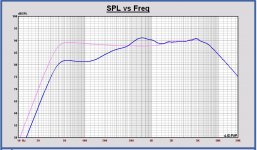
Bafflestep respons
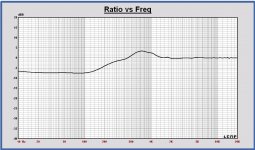
You see that Leap simulates more bafflestep boost than your tool, about 2dB more.
I have checked Leap on this point in the past with measurements, the Leap diffraction simulator is very accurate. But only for not too complex enclosures.
It explains the SPL differences between your and my simulation around 800Hz, a difference that Cucicu also measures.
Paul, there you have your answer where the two extra decibels came from. Regarding our buddy cucicu, I start to think that this whole business is about pulling people's legs! First there is this nasalness in sound, then the impedance measurements are ok, then microphone isn't worth a thing...etc
Would someone send me these darn speakers so I can build a proper crossover in exchange for say, a Ferrari 308 ?
Would someone send me these darn speakers so I can build a proper crossover in exchange for say, a Ferrari 308 ?

Leap is a product of LinearX, not freeware, you have to buy it. And it takes some time to learn it, but then it is a very nice tool.Very good software leap...where is possible to take it?
http://www.linearx.com
I have almost a redesign of the filter ready, with the 2.2mH.
I will post it very soon.
Paul, there you have your answer where the two extra decibels came from. Regarding our buddy cucicu, I start to think that this whole business is about pulling people's legs! First there is this nasalness in sound, then the impedance measurements are ok, then microphone isn't worth a thing...etc
Would someone send me these darn speakers so I can build a proper crossover in exchange for say, a Ferrari 308 ?
Lojzek,
At first good measurements should been done, I agree.
The 800Hz bump will be hard to remove completely from the power response, I bet it is caused by poor design of the front baffle. A 225mm rectangular baffle with the driver positioned on the center vertical axis will exhibit very audible diffraction ripple. Try to simulate a notch centered at 800hz that would thame it by 3db, that would work on-axis (still total radiated energy would be flawed). A single cap parallel to the first coil may be enough.
The power is not affected by the baffle response but the distribution of the power is not uniform around 800Hz for this baffle. As a consequence the SPL is boosting around the on axis, but not in full sphere.The 800Hz bump will be hard to remove completely from the power response, I bet it is caused by poor design of the front baffle. A 225mm rectangular baffle with the driver positioned on the center vertical axis will exhibit very audible diffraction ripple. Try to simulate a notch centered at 800hz that would thame it by 3db, that would work on-axis (still total radiated energy would be flawed). A single cap parallel to the first coil may be enough.
Look to the infinite baffle respons (pink) compared with the full space response (blue) at horizontal 0 degrees and horizontal 60 degrees.
0 degrees
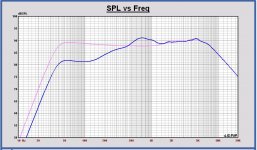
60 degrees
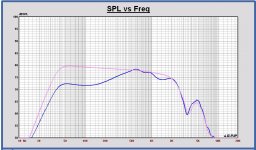
This means that you always have to be careful by placing notches, because it is affecting the power in the room. The sound at the listening position is determined both by the SPL on axis response and the power response. In general the bafflestep respons on axis will be compensated.
It is the story of Floyd Toole.
This is all very interesting. We've all struggled with this 6" speaker. Because it needs a biggish 2.2-2.7mH bass coil and that just doesn't play nicely.
One answer seems to be to use a traditional passive RL bafflestep filter:
mh-audio.nl - Home
I just threw in some numbers for a 23cm. baffle and a 0.7mH SEAS ER18RNX:
http://www.ampslab.com/starling.htm
Voila! Michael Chua's bass design! 😎
One answer seems to be to use a traditional passive RL bafflestep filter:
mh-audio.nl - Home
I just threw in some numbers for a 23cm. baffle and a 0.7mH SEAS ER18RNX:
http://www.ampslab.com/starling.htm
Voila! Michael Chua's bass design! 😎
Attachments
Cucicu,
Filter 03 with your 2.2mH 🙂.
Schematic filter 03
View attachment 602491
SPL with filter 03
View attachment 602492
With R5 you can adjust the level at 800Hz.
With R5 higher there is less paper sound. You can try R5=8.2.
Hi Paul, this seems really good. I'm gonna try it and let you know.
But, I'm having a nice time with this crossover, can you simulate just for my curiosity? it seems it has a good equilibrium...regards
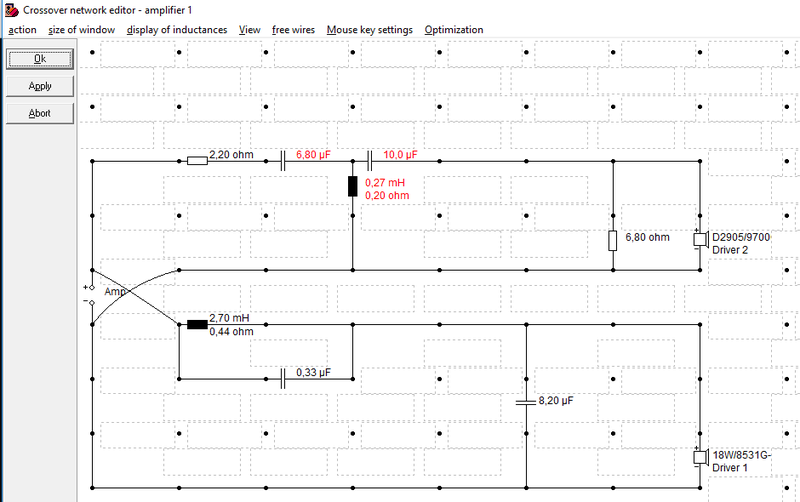
The 800Hz bump will be hard to remove completely from the power response, I bet it is caused by poor design of the front baffle. A 225mm rectangular baffle with the driver positioned on the center vertical axis will exhibit very audible diffraction ripple. Try to simulate a notch centered at 800hz that would thame it by 3db, that would work on-axis (still total radiated energy would be flawed). A single cap parallel to the first coil may be enough.
Maybe you 're right but consider that many commercial 2 way speakers have rectangular baffles, but in this case builders may use custom drivers (see proac and many others).
But also many diy 2 way designs are on rectangular baffles like zaph audio or rbj audio, humblehifi and many others.
So looking at zaph design, 23cm wide baffle, standard 18w 8531, sure there will be that bump at 500-1000hz, I don t see any baffle step compensation in this design.
So maybe that bump itself is not compensated (notch filter) but is masked with another bump in the FR, may be at 2khz (see proac response 2.5).
I also think the problem for these baffles is more likely a bump on 500hz that on 800hz.
What do you think?
But, I'm having a nice time with this crossover, can you simulate just for my curiosity? it seems it has a good equilibrium...regards

Hi Cucicu
These are the responses of this one, filter 04
schematic filter 04
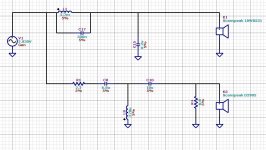
SPL filter 04 and LR4 2000Hz targets
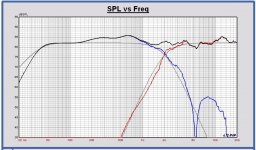
You make the overall SPL more flat above 200Hz, the tweeter response more on the level of the mid frequency response of the woofer. Are you not missing the deep low frequencys? Maybe you have to test filter 03 also. It is more flat down to lower frequencies. Then you can compare. This should be interesting to know.
There is no real need to design a speaker flat down to low frequencies. It depends on your room also. Mostly in my own designs with 7 inch drivers, I make the speaker flat down to 100Hz and a slow roll off to low frequencies.
We are looking now only to the SPL on axis. I will have a look to the power response and the off axis responses also.
As a comment to some previous posts in this topic, the problem with this speaker is the combined response of this 7 inch driver on this baffle. It results in a big bump at 800Hz on axis. With smaller 5 inch drivers on such baffle you mostly have a more flat SPL because the bafflestep boost does compensate more for a flat SPL.
As an information I have very good experience with baffles with a small flat horizontal front baffle part and rounding slowly to the sides. In that case the boost of the baffle can be made very low.
This is all very interesting. We've all struggled with this 6" speaker. Because it needs a biggish 2.2-2.7mH bass coil and that just doesn't play nicely.
To design the SPL of this speaker flat starting from 100Hz you have to choose these bigger coil values.
Why do you think it will not play nicely? In the case you design the woofer SPL response on target, i.e. LR4 2000Hz, up to high frequncies, it should be ok in my opinion. Probably you have to shunt the coils with a resistance or a capacitor to realize the best map on target.
ok Paul, at this point I will try xover 03, indeed the two inductors 2,7 and 2.2mh in series are not a typical design.
I hope you can look also at off axis response and try to realize a mor conventional xover for this baffle (I'm worried about the resistance of the two coils on the woofer making deep basses a little lacking).
Maybe you could try to mantain tweeter xover of the xover04 and readjust just bass part, the tweeter in 04 config sounds quite good. don't know.
regards
I hope you can look also at off axis response and try to realize a mor conventional xover for this baffle (I'm worried about the resistance of the two coils on the woofer making deep basses a little lacking).
Maybe you could try to mantain tweeter xover of the xover04 and readjust just bass part, the tweeter in 04 config sounds quite good. don't know.
regards
The power is not affected by the baffle response but the distribution of the power is not uniform around 800Hz for this baffle. As a consequence the SPL is boosting around the on axis, but not in full sphere.
I would disagree with this statement. The propagation of the secondary diffration wave provoked by the edge being illuminated is at up to 90 degrees and would produce an add-on product off-axis and alter the ripple as well. If you move 90 degrees off-axis, then you`d have no ripple at all. Even at 60 degrees the ripple could (on such 21cm baffle) be in the vicinity of +1db or so plus a dip but it will not be that ragged and will be pushed higher in frequency. What matters to me is more what happens in the 0-45 degree window and there you`d have enough ripple to add diffraction effects to the off-axis response. And when they reflect they`d be a part of your total response and what you hear. Some people don`t perceive differences of 2db, some do 0.5db. Besides, the electrical approach would yield a flatter on-axis reponse at the cost of a dip off-axis.
So looking at zaph design, 23cm wide baffle, standard 18w 8531, sure there will be that bump at 500-1000hz, I don t see any baffle step compensation in this design.
The BSC is incorporated into the inductor size, he just used a larger one, a very common approach that may work most of the time so you get away by not adding extra cost to the xover.
- Home
- Loudspeakers
- Multi-Way
- Scan-Speak crossover help
